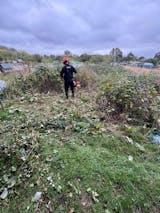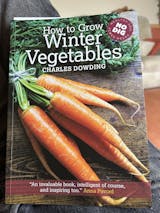Main image is small garden 15th June, see video. Broad beans are finished, strawberries, peas and lettuce are in full flow, courgettes starting to crop.
Giving water
Full summer is arriving here, with dry heat forecast up to 30°C, mid-80sF. This is after a very dry spring. Thankfully, however, June until 15th has been somewhat damp with 35mm rain, enough to reduce the need for watering.
In much of the UK, watering is not normally a big issue, but this summer it could be. I use a hose from the mains tap, with two Abimax magnetic water devices to improve the quality and hydration. Use NODIG at checkout for 10% off the Abimax.
Hand-watering takes more time, and uses less water overall while ensuring the needy plants receive it..

Sow now or soon

Now it’s good to sow more brassicas: cauliflower for autumn, savoy cabbage for winter and broccoli for overwintering.
Sow root vegetables such as beetroot and carrots. The former is good multisown to transplant, the latter direct, even between other plants such as lettuce that finishes soon.
Continue to sow salads, mainly lettuce. Sow brassica salads in early August, after their flowering season, and when flea beetles are fewer.
See my short video for details.

Parsnips, sow very soon

Parsnips can still be sown, before the end of June. It's not always easy in summer, because you need to keep the sown area moist for two weeks, to allow seeds to germinate. After finishing this newsletter, I’m out there watering the parsnip beds.
Finding space
There are not no many empty spaces.
A good trick is to pop new seedlings, or seeds, between plants are not too large, and which will finish their cropping cycle soon. Currently that includes lettuce, salad onions, carrots, and hardneck garlic.

Rotation is not mandatory!
In my no-rotation trial, the Charlotte potatoes are now year 11 in the same soil. See photo below.
Have you ever wondered why four years? It comes from 18th century farming, developed by the Earl of Townshend in Norfolk, 1733. He developed a 4th year of turnips and clover for his sheep.
Quite different to growing vegetables in a small space.

Cucumber problem
Cucumbers can be fragile, and some of my polytunnel plants have suddenly wilted at the top. I mention it in the tour video where from the comments, it sounds like a few of you have a similar problem.
Possible causes are big differences in night and day temperatures, moisture shortage on a hot afternoon, and bacterial infection. There are no aphids.

Tomato leafroll
Certain tomato plants are susceptible to this, and it's to do with large differences between night and day temperatures. Like, I notice it more on tomatoes in the polytunnel, compared to ones growing outdoors.
Another factor is that some varieties are more susceptible than others.
I know of no remedy, and it's not too harmful to growth

Aphids
These have been prolific this spring. I wash them off and just aim to keep their under control, with not too much leaf damage.
Now the predators are arriving. I'm seeing hoverflies and ladybirds. Ladybird larvae eat a lot of aphids.
See my Pests and Diseases mini-course.

Weak seed composts
This is a big problem! I know from the many comments I receive, such as this oone by email.
"I have gardened all my life and had an allotment for around 30 years. This is the first year that I have used totally peat free compost for seedlings and the first time ever that I am experiencing a total flop. Flowers planted in April are still only 1" tall. Germination was good and then they just stagnated - too small to put out.
For next year - can I mix home made compost with the peat free compost for seedlings? I have resorted to feeding them to try and get them to grow but I would rather not do that.
I am not the only one struggling - lots of other gardening friends have the same problem."
It should not be necessary to feed potting mixes. Nor is it necessary to use "seed compost".
The term seed compost is highly misleading. Not deliberately, but it appears to be based on the false assumption that seeds cannot germinate in compost/potting mixes with high nutrient status.
This is completely untrue, as we see on heaps of old manure, where many seeds are germinating! Problem is that it gives a chance for compost companies to pass off almost anything, as suitable for sowing.


Making compost
There is now a lot of waste green matter to compost. From crop residues to grass clippings, hedge trimmings, weeds and kitchen wastes.
I put everything in the compost heap, even if its not hot.. Many additions now are ‘green’ (fresh, nitrogenous) in composting terms. So I have found that it pays to carry a stock of ‘browns’ such as 6-12 month old woodchip. I sieve it to 12mm with a throw-through sieve.
Browns can also be old tree leaves, woody prunings, cardboard, paper and more.
When your compost is more than about six months old, it should be filling up with worms. Then after another 2 to 3 months, that becomes worm compost / vermicompost. You can mix that 20 to 30% with a week purchased compost, to help it work properly.













































0 comments